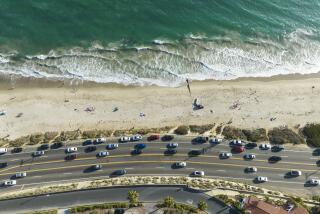O.C. Sewage Not Flowing Back to Beach, Study Finds
- Share via
The sewage that a local sanitation district pumps four miles out to sea does not appear to be flowing all the way back to the Huntington Beach shoreline, according to preliminary study results released Wednesday.
The early findings are part of a $5.1-million Orange County Sanitation District study to determine whether the 243 million gallons it pumps into the ocean every day is pushed back to Huntington’s shoreline. The preliminary findings show that the plume comes within a mile of the beach.
“The plume comes in toward shore,” said George Robertson, the district’s chief scientist. “But we haven’t seen it come to the beach.”
Some environmentalists contend, however, that the study is self-serving because the sanitation district stands to lose hundreds of millions of dollars if it is proved to be the cause of beach pollution.
“I’m expecting them to come up with a clean bill of health,” said local environmentalist Doug Korthof.
After major health warnings forced beach closures for much of the summer of 1999, scientists, county health officials and state water officials have been trying to determine the source of the problem. Bacteria levels continued to rise at Huntington State Beach in 2000 and again this summer, causing warnings but no closures.
In November, UC Irvine scientist Stanley Grant theorized that a combination of forces--underwater waves and tides and a nearby power plant’s ocean water-fed cooling system--is drawing the sewage back toward shore.
“One link in the chain seems to be satisfied,” Grant said of the preliminary findings. He said he doesn’t think his theory has been disproved. “The other link, perhaps involving the AES power plant, has not been established.”
The plant has been shut down for retooling, so it wasn’t running its cooling system--which cycles 300 million gallons of ocean water daily--during the four water-quality surveys conducted this summer. The plant will be running its cooling system during the remaining two 48-hour surveys, the first of which will begin Sunday.
In the summer’s earlier surveys, the sewage plume was seen around the one-mile monitoring stations only during a high flood tide; hot spots of bacteria at the beach were seen during ebb tides.
Korthof, a longtime critic of the sanitation district, said he was not surprised by the results. “There are two flaws in the study. [UCI researcher Grant] is not involved in the experiment, design or analysis, and he’s the one who came up with the theory. Second, they’re not testing his theory because the AES plant is not running.”
District officials emphasized that the findings are extremely tentative because much of the data--including readings from 11 moorings that will measure the current every five minutes through October--is not in yet. “What we’re talking about today is preliminary data,” said spokeswoman Lisa Murphy.
Additional studies, totaling $2 million, will include revisiting possible inland sources. Final results are not expected until next spring. Huntington Beach has also announced plans to use $4 million of Proposition 13 funds--a $2-billion water bond passed last year--to fight urban runoff pollution.
(BEGIN TEXT OF INFOBOX / INFOGRAPHIC)
Pollution Findings
Monitoring tests showed that sewage released four miles offshore came within one mile of Huntington Beach’s shore on July 5. The tests are part of a $5.1-million study to determine if the offshore sewage discharges are causing high bacteria levels along the beach.
Source: Orange County Sanitation District
More to Read
Sign up for Essential California
The most important California stories and recommendations in your inbox every morning.
You may occasionally receive promotional content from the Los Angeles Times.











